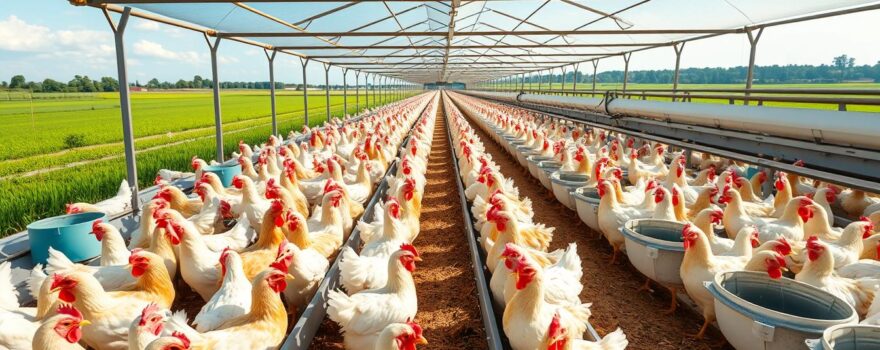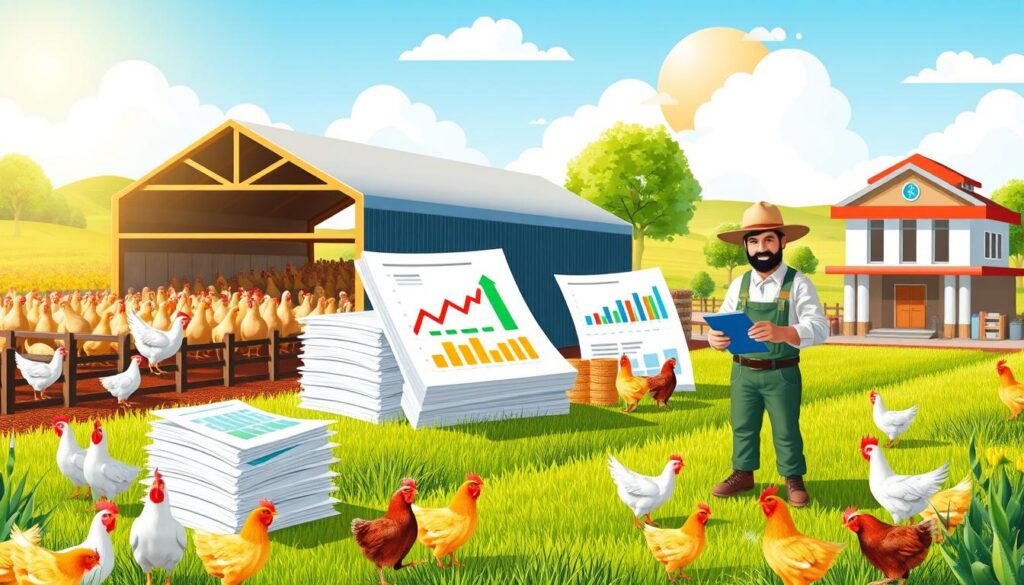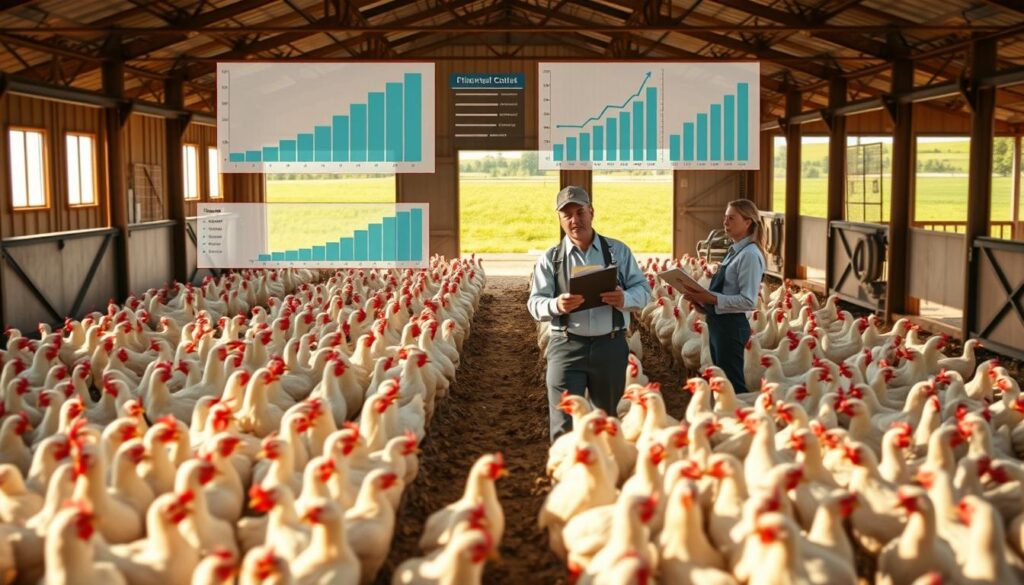
Successful broiler farming needs careful financial planning. This guide covers key financial management for broiler farmers. It includes understanding the industry, calculating startup costs, and finding financing strategies.
It also talks about identifying revenue streams, conducting market analysis, and mitigating risks. By following these steps, broiler farmers can improve their operations and profits. They can also handle the challenges of the poultry industry better.
Key Takeaways
- The Importance of Financial Planning in Broiler Farming
- Cash Flow Management for Broiler Farms
- Cost Analysis and Profit Maximization Strategies
- Effective Risk Mitigation and Financial Forecasting
- Strategies for Sustainable Investment and Debt Management
Understanding the Broiler Farming Industry Outlook
The global poultry market is expected to hit $375.41 billion by 2030, growing at 3.5% annually. This growth is also seen in the U.S., where broiler and turkey production is strong. The U.S. sees 15.9 billion in fresh meat sales and 5.74 billion pounds of turkey each year.
The chicken and turkey meat production industry in the U.S. was worth $59.1 billion in 2023. This shows how important this sector is. Hormel Foods Inc., a major player, had $12.5 billion in net revenue.
Global and U.S. Market Size and Trends
The global poultry market is growing due to more demand for protein-rich foods. People also want leaner meat options, and poultry is affordable. In the U.S., the poultry industry keeps growing, offering chances for broiler farmers.
Major Players and Market Leaders
The poultry industry has many big players and leaders. They help the sector grow and develop. Hormel Foods Inc. is a great example of how poultry businesses can succeed.
As the global poultry market changes, broiler farmers and others in the industry have exciting opportunities ahead. These will shape the future of this growing and dynamic industry.
Calculating Startup Costs for Broiler Farming
Starting a broiler farm needs a good grasp of startup costs. These costs vary based on the farm’s size and scope. They mainly include land, building poultry houses, and buying equipment and livestock.
Land Acquisition and Construction Costs
Buying land for a broiler farm can cost between $3,500 and $5,000 per acre. Building poultry houses, employee homes, and storage adds more costs. These can range from $20,000 to $150,000.
Equipment, Machinery, and Livestock Investments
Broiler farmers also need to buy important equipment like feeders and incubators. These can cost between $5,000 and $50,000. Buying chicks or poultry stock is another big expense, costing $1,000 to $10,000.
Startups must also consider labor, marketing, and licensing fees. Getting these costs right is key to making a solid budget and finding the right funding.
| Expense Category | Estimated Cost Range |
|---|---|
| Land Acquisition | $3,500 – $5,000 per acre |
| Poultry House and Facility Construction | $20,000 – $150,000 |
| Equipment and Machinery | $5,000 – $50,000 |
| Livestock (Chicks) | $1,000 – $10,000 |
| Labor Expenses | $1,000 and up |
| Business Licensing and Permits | Varies by location |
Starting a small broiler farm can cost between $5,000 and $30,000. Medium-scale farms need about $75,000. Large farms can cost up to $2 million or more.
Determining Financing Requirements and Strategies
Starting a successful broiler farm often needs money beyond what you have. Broiler farmers can look at different ways to get money, each with its own rules, rates, and how you pay back. These include bank loans, Small Business Administration (SBA) loans, private investors, partnerships, and crowdfunding sites.
To find the best Broiler Farming Financing Options for their farm, farmers need to think about their goals and how much risk they can take. Having a solid plan for getting money is key to getting the funds needed to start and grow a successful broiler farm.
Loan Types for Broiler Farming
- Traditional Bank Loans: These loans have good rates and terms, but you might need to put up collateral and have a good credit score.
- SBA Loans: These are backed by the government and have better terms, made for small businesses like broiler farms.
- Private Investor Funding: Investors might give you money in exchange for a share of your profits or business.
- Crowdfunding Platforms: Use online sites to get money from many people, often for specific projects or to buy equipment.
Funding Strategies for Broiler Farming
- Develop a Comprehensive Business Plan: A detailed plan that shows how you will farm, your market, and your finances is key to getting money.
- Explore Government Grants and Subsidies: Look for grants from the government, states, and local areas for things like building, research, and green practices.
- Leverage Partnerships and Joint Ventures: Working with other farmers or industry partners can help you find more money.
- Diversify Income Streams: Try making money in other ways, like selling eggs or processing food on your farm, to make your farm more stable financially.
| Financing Option | Interest Rates | Repayment Terms | Collateral Requirements |
|---|---|---|---|
| Traditional Bank Loan | 5-10% | 5-10 years | Yes |
| SBA Loan | 4-8% | 7-25 years | May be required |
| Private Investor Funding | Varies | Flexible | No, but equity stake required |
| Crowdfunding | N/A | N/A | No |

The Importance of Financial Planning in Broiler Farming
Financial planning is key to a successful broiler farm. It involves budgeting, keeping records, and analyzing finances. These steps help manage cash flow, control costs, and boost profitability.
Good cash flow management means farmers can pay for things like feed and vet care. It also helps cover labor costs during the production cycle.
Doing a detailed cost analysis can help farmers save money. This leads to more profit maximization. By planning financially, farmers can make smart choices, avoid risks, and stay sustainable in the long run.
Cash Flow Management
Managing cash flow well is vital in broiler farming. Farmers need to track their money in and out. This ensures they have enough to pay for expenses like feed and vet care.
They also need to manage when they sell broilers and get revenue. This helps keep their finances in balance.
Cost Analysis and Profit Maximization
Doing a deep cost analysis is crucial. It helps farmers find ways to cut expenses and increase profit margins. They can look at feed costs, operation efficiency, and ways to reduce waste.
By focusing on profit maximization, farmers can keep their business strong. This leads to better financial success over time.
“Successful broiler farming requires the integration of farming practices with sound business management, emphasizing the importance of technical and financial planning for sustainable operations.”
Identifying Revenue Streams for Broiler Farming
Broiler farming offers many ways to make money, not just by selling meat and eggs. By knowing what the market wants, how to price things, and what customers like, farmers can make more money. They can also sell other products like processed poultry, feathers, and manure. Or, they can start agritourism to make their business stronger and more profitable.
Sales of Poultry Meat and Eggs
In 2015, broiler farming was a big deal in Oklahoma, making $771 million. This was a big jump from 1993, when it made $240 million. Most of the time, farmers work with big companies that pay them for each pound of chicken they raise. They also get extra money for being efficient and keeping costs down.
Diversifying Income Sources
- By selling things like nuggets or pre-cooked meals, farmers can make more money.
- They can also sell feathers and manure to other businesses, adding to their income.
- Starting agritourism, like farm tours or petting zoos, can bring in more money and connect with the community.
By finding and using different ways to make money, farmers can make their business stronger. This helps them stay stable and grow, even when things get tough.
| Revenue Stream | Potential Benefits |
|---|---|
| Poultry Meat and Egg Sales |
|
| Processed Poultry Products |
|
| Byproduct Sales (Feathers, Manure) |
|
| Agritourism |
|
“Growers should thoroughly examine and understand contract terms related to payments, production practices, incentives, and responsibilities before committing to broiler production.”
Market Analysis and Financial Projections
Doing a deep Broiler Farming Market Analysis is key for good Financial Forecasting and smart business choices. It means looking at industry trends, checking out what competitors charge, and knowing what customers want. A smart pricing plan is vital to make enough money and stay profitable.
Also, making Sales Projections based on past data, seasonal trends, and demand helps farmers plan their finances. There are tools like financial software, spreadsheets, apps, and budget templates to help with planning.
By comparing what’s happening now with budget plans, farmers can see how they’re doing. They can spot problems and change their plans. It’s smart to get insurance to protect against money troubles. Also, having different ways to make money helps keep farms stable.
“Investing in management training for acquiring financial skills can aid in making informed decisions and optimizing budget planning in poultry farming.”
With a thorough Broiler Farming Market Analysis and detailed Financial Forecasting, farmers can make better choices. They can set smart prices and predict sales. This leads to a more successful and profitable farm.

Risk Mitigation and Financial Forecasting
Being a broiler farmer means you must be ready for the poultry industry’s ups and downs. You face risks like market changes, diseases, and unexpected costs. Good financial planning helps you manage these risks and keep your business thriving.
Scenario Analysis and Contingency Planning
Scenario analysis is key to Broiler Farming Risk Management. It helps you understand how different market situations might affect your business. You look at how price changes, feed costs, and diseases could impact your expenses and profits.
Also, creating contingency plans is vital for Financial Forecasting. These plans show what to do when unexpected problems arise. They help your business stay strong and make smart choices in tough times.
The secret to managing risks and forecasting finances in broiler farming is to be ready for anything. Anticipate different scenarios, have solid contingency plans, and stay flexible with the market. This way, you can make your broiler farm financially stable and set it up for success in the long run.
Record-Keeping and Financial Literacy
Keeping detailed records is key for Broiler Farming financial planning. You need to track expenses, income, and production data. This includes growth weights, feed use, and environmental factors. This info helps analyze the farm’s finances, spot improvement areas, and make smart choices.
Also, having good Financial Literacy helps broiler farmers manage their finances better. They can learn through self-study or get help from experts. This leads to better Financial Management and helps the farm last longer.
- Record-keeping helps in monitoring and evaluating profit or loss, and for efficient business management.
- Financial decisions are reliant on analyzing records for budgeting and major financial choices.
- Records assist in avoiding mistakes and making informed breeding decisions.
- Productivity records help in determining when to cull the flock and assessing performance.
- Records provide valuable information for future planning, changes, and expansions.
Keeping specific records is important in a poultry farm. This includes Equipment Register, Feed and Feed Ingredient Register, and Egg register. The type of records needed varies based on the poultry species, breeds, and types of birds.
It’s vital for broiler farmers to understand their finances. Studies show that gender, age, education, and bank visits affect their financial knowledge.
“Accurate records and financial literacy empower broiler farmers to make data-driven decisions, optimize their operations, and achieve long-term sustainability.”
By keeping detailed records and improving financial literacy, broiler farmers can make better choices. This leads to higher profits and ensures the farm’s success over time.
Financial planning is key for broiler farming success. It helps farmers understand Broiler Farming Financial Planning. They need to know startup costs, get the right financing, and find ways to make money.
They should also do market analysis, manage risks, and stay financially literate. This way, they can make smart choices and grow their business. Good financial planning helps farmers deal with the poultry industry’s changes and stay strong.
The key takeaways show why financial management is crucial. Broiler farmers must look at the industry, figure out their needs, and plan well. They need to manage money, keep costs down, and make more profit.
By being careful and proactive, farmers can succeed in the competitive poultry market. They will be ready for the future and find new chances.
Putting strong financial planning into broiler farming is vital for making and keeping profits. Farmers who follow these steps and keep improving their financial skills will do well. They’ll be ready for the industry’s changes and grab new opportunities.